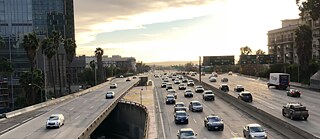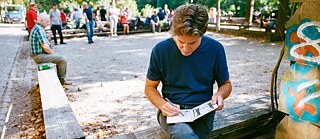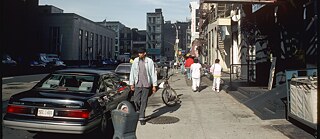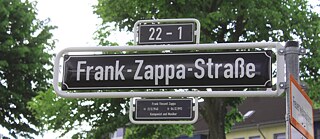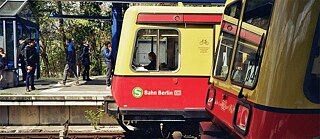At a Standstill
Traffic
Most city dwellers view traffic as an unavoidable downside of urban life. But according to Susanne Papawassiliu, freeway standstills have their benefits. In this episode, Susanne speaks with traffic experts, city planners, and professional drivers in Los Angeles and Berlin about congestion on the roads.
Listen to this episode: Apple Music | Spotify | Download
This episode comes from Susanne Papawassiliu. Susanne is a broadcast journalist who works in television and radio, mostly for the German networks RBB and Deutschlandfunk Kultur. She lives in Berlin. In this episode, she discusses the traffic dilemma in the German capital and its sister city, Los Angeles. The traffic reports featured in the episode come from KXLU and KFI in Los Angeles and RBB in Berlin. The photo for this episode shows highway congestion in Los Angeles. If you liked this episode, check out Susanne’s other episode “Adventure.”
Transcript
Susanne Papawassiliu: This is Susanne Papawassiliu for THE BIG PONDER. And this is Reverend Dan from KXLU Radio in Los Angeles.
[TRAFFIC REPORT]
Susanne Papawassiliu: His unique traffic report nails it. It’s vague yet somehow accurate. Always. In this episode of THE BIG PONDER, I will try to find out about traffic jams. Standing still in traffic —nothing really anybody likes, but it’s part of our lives. Nothing we can controlif we drive a car. And especially when you live in Los Angeles or in Berlin. And it drives most people insane. Most, but not all. So what does it do to you, getting stuck?
Michelle: Well, it depends. If I’m late for something, it’s very stressful. But if I’m not late for something, I kind of enjoy it in a weird way because I always like to see what I’m passing by. And I get to look inside the cars next to me and wonder about the lives of those people who are stuck in this same river of cars. If there’s anything interesting, you know, next to the traffic area, I love it.
Susanne Papawassiliu: This is my friend Michelle. We’re driving back to Los Angeles from a visit to Mount Baldy in the San Gabriel Mountains. When it comes to traffic, or traffic jams, she’s a bit like me. I live in Berlin, where I rarely drive a car. But I remember even as a child, I found traffic jams exciting. You could see who was sitting in the other cars and think about what people were doing, who they were, where they were going. I wasn’t in a hurry. There’s a poem from the Indian writer Namil Kamar that somehow relates to that. [READING ALOUD]
“Traffic Jam”
As I drive out from home
I forget suddenly
where I’m headed.
But when I’m in a hurry
and stuck in traffic jams
I grow restless
and I remember
Many people tell me —
“I saw you the other day
in the traffic jam”
Yes!
But who was it that saw me in the traffic jam?
I have to enter another traffic jam
to remember.
Susanne Papawassiliu: I have never really been in a bad traffic jam lasting one or two hours. Most people get stressed out about it after a few minutes. Like my father who was always totally annoyed. When I’m driving on the freeways, I find it almost pleasant when things slow down or come to a stop. I get more stressed out when everyone is driving really fast — too speedy for me. [TRAFFIC REPORT] With traffic like that, how relaxed could someone be who drives for a living? I meet Laura, she’s a driver for Lyft, a competitor of Uber. I thought she would be super annoyed getting caught up in traffic jams, but to my surprise, she’s relatively cool about the whole thing.
Laura: Like here on Google Maps, it says that there’s a nine-minute delay to where we’re going because of an accident.
Google Maps: Continue on U.S. 101 South for two miles.
Laura: And so, you know, then it’s a choice. If you’re smart enough, and you’re looking at an app, then you get off the freeway and take a side road because it’s always gonna be better than being trapped on the freeway.
Susanne Papawassiliu: Okay, but if you can’t?
Laura: Then, you make the best of it. I mean, I think driving Lyft, there isn’t ... You know, you’re kind of forced to have — not forced, but, you know, you have people ... Some people wanna talk, some people just wanna sit there. That’s always either makes it a pleasure or, you know, like the longest 20-minute ride that you could ever go on.
Susanne Papawassiliu: “Make the best of it” —that’s her motto — and maybe there’s also something positive when the flow of traffic comes to a standstill, and everything stops or just crawls.
Laura: Well so, I look at the people in my car. Like people who are gonna do a little bit of across-town drive — like you and I were going to be in the car for like the next 25 minutes, let’s say. And I kind of look at it as your opportunity to ask any question you want. About anything. And the person in the back can say, I don’t really wanna talk right now, or they might answer you. And so sometimes, you can really have the most amazing conversations. Like I had this one guy, he looked like a college professor, kind of a little stuffy, maybe a math professor, something very conservative. And he was into following the alien conferences. And it was the longest drive. It was all the way from Silver Lake all the way down to where the airport is in Los Angeles, which is about an hour away with traffic. Then, I said: So what’s this conference? I mean, it’s quite a far away, a ways to go, you know, is it something you’re into or is it part of your job? And then, he told me, you know, it was kind of following this one guy who’s really into extraterrestrials.And I said: Well, what do you think about that? And so then, he gave me like his whole opinion of it. And what, why he believed in it, which, you know, where else would I get that conversation? It was just ... It was like story time. And so, really traffic — and somebody who chooses to take a long ride — it’s kind of cool because you get to ask them anything you want.
Susanne Papawassiliu: So being stuck in traffic can have its —
Laura: Story hour!
Susanne Papawassiliu: Good sides.
Laura: It has lots of stories. So, I think that’s the ‘traffic plus’ or a ‘long ride plus,’ which is the same thing because traffic makes your ride longer.
Susanne Papawassiliu: For traffic experts in Los Angeles, the fact that people have already become accustomed to daily traffic jams is nevertheless unacceptable. Michael Manville is such an expert. He is an Associate Professor for Urban Planning at the UCLA Luskin School of Public Affairs.
Michael Manville: One way to think about this is that traffic is a reality in most big cities. And so, it’s healthy, if you accept that reality, to find a way to be good-natured about it. But we shouldn’t have to have coping mechanisms to deal with the chronic failure of our public services, right? Imagine if every day for hours the electricity went out, right? And then, some people would say to you, well, you know, but I think it’s good family time, and you know, I’m not watching TV, which I didn’t really want to do anyways. And we chat a lot, and candlelight is very nice. And all those things are true. But actually, electricity is pretty important, right? And so, like it really is the case that in a metropolitan area of eight million people, you know, people need to get places, and the government has promised to help them get places. And every day, it fails.
Susanne Papawassiliu: Attempts have been made for decades to beat the traffic jams of Los Angeles. So far with little or no success. For the most part, there was the idea of simply adding more lanes to the freeways.
Michael Manville: Oh, yeah. I think that in the United States for the first few decades of the postwar years that was the go-to way to manage congestion. It gradually became more and more controversial because it’s often quite destructive. But even today, you know, a lot of highway agencies have not given up on the idea that you have a congested freeway or even a congested service street. And the thing to do is add a lane to it.
Susanne Papawassiliu: It seems like a logical idea. There are so many — too many — cars on the freeway, so just add another lane or two.
Michael Manville: Right. So, if you think about here we are in Los Angeles, 8 a.m. on the 405 freeway. It’s a nightmare. And the fact that it’s a nightmare means that some people are going to take a trip at 6 a.m. instead of 8 a.m. to beat the traffic. And some people are going to ride a train instead of get on that freeway to beat the traffic. And some people are going to take a different route. They’ll weave through the canyons on a surface street instead of being on that freeway at a busy time. And so, if you widen the road, it’s true that initially the road starts moving faster. But what does that do? I mean, in a sense, it lowers the price of being on that road, right? And so, some people who would have gotten up at 6 a.m. now get up at eight, some people who would have ridden the train now get in their car, some people who would drive through the canyon road, get on the freeway, and in short order, the road is every bit as congested as it once was. Now, in fairness to the people who like road widening, it’s carrying more people, right? But none of them are moving any faster.
Susanne Papawassiliu: Michael Manville has been researching the field for 15 years and has had to throw his initial convictions overboard in the process.
Michael Manville: When I first came to graduate school, I thought the solution to traffic congestion was public transportation. But it’s not.
Susanne Papawassiliu: Why not?
Michael Manville: The same reason widening a road isn’t, right? You know, all the things that we just ran through. Like what happens when you widen, when you add a lane to a freeway? The same exact thing would happen if you built a train next to that freeway, right? Some drivers would be pulled off the highway and onto that train. The highway would start moving a little faster. And next thing you know, some people who had gotten up early or taken another route or taken another mode would realize that the freeway was a little faster, and they would get on it. So, what public transportation does — which is extremely important — is it gives you another choice, and it lets you avoid congestion. But it doesn’t fight congestion — if by fight congestion, we mean the road moves faster. So think about London. Think about Tokyo. Think about New York City. Absolutely, you know, when they’re working, you know, fabulous public transportation systems that operate right beneath very congested roads. If public transportation reduced congestion, that wouldn’t be true. Tokyo would have no congestion. London would have no congestion. But the only place in London that doesn’t have much congestion is in its congestion-charging zone.
Susanne Papawassiliu: Congestion charging — or congestion pricing — means that you pay something for using something, in this case the freeways, because you use them during the peak hours, and thus, contribute to congestion. Every so often, the idea for a so-called city toll is discussed in Berlin to relieve the inner city of traffic. So far without success. However, Berlin has a very well-functioning public transport system. But even here, it is almost impossible to avoid traffic jams on some of the city’s freeways or on the surface streets. But compared to Los Angeles, Berlin is actually more of a paradise when it comes to traffic jams.
Micha: [VOICEOVER] The traffic jams here are completely different. Traffic jams in Berlin aren’t that bad. But of course, we’ve grown tremendously. We’ve all known that since the mid-2000s, Berlin has become insanely hip. We have grown tremendously. We have around 400,000 more inhabitants. In Los Angeles, I have the feeling that people are growing up with this congestion phenomenon. It’s really insane in L.A. No, that can’t be compared to here.
Susanne Papawassiliu: This is Micha, he’s a real Berliner with a Berlin dialect. He’s a good-natured guy around 50 and has been driving a cab in Berlin for over 14 years. Until 2021, you had to take a local knowledge test to get your certificate to be a cab driver. Now, the obligatory navigation system in the car takes care of that. But Micha has learned properly the most important connections and routes throughout the city. And he still relies on this knowledge only. He only looks at the usual apps to check the traffic situation. He’s an optimistic person, meaning he doesn’t complain too much or get upset when things don’t work out as planned — or in that matter, don’t flow fast enough.
Micha: [VOICEOVER] First of all, I try to resolve the issue with the customer. Whether it’s ok for him to take a different route. Not exactly the shortest one in some cases. And then, it’s a matter of finding a solution right away if possible. Of course, anticipating things in advance. Unexpected traffic jams cannot be taken into account, of course, but the classic daily traffic jams can be foreseen and, in some cases, even avoided.
Susanne Papawassiliu: [VOICEOVER] Emotionally, does it annoy you?
Micha: [VOICEOVER] Yes, of course. For a short moment, it can happen that I am annoyed. Absolutely. Absolutely. Because of course, it’s my working time, and among other things, also life time. And the turnover, you know. For us, time is also a very important factor, so to speak. If you have a day when the traffic is heavier, you’ll have fewer customers. And if you haven’t earned your money by a certain point in the day, you won’t be able to catch up anymore.
Susanne Papawassiliu: We drive on the A100, a city freeway in the direction of the famous Funkturm, the radio tower, and the trade fairgrounds. The traffic is getting heavier. Actually, it is most always too dense here. Vast columns of cars — or as we refer to it in German, sheet metal avalanche, ‘Blechlawine’ — is only slowly making headway. But we are still rolling in spite of that.
Micha: [VOICEOVER] This junction is chronically overloaded in Berlin, more than overloaded. It is the busiest freeway intersection in Germany, I would say. There’s a major reconstruction of it in the planning. It jams up here, sometimes the whole day in this area. From here, it leads to the Autobahn towards Magdeburg, Leipzig, and also to the former racing track Avus. There are quite a lot of entries and exits close to each other.
Susanne Papawassiliu: [VOICEOVER] So it doesn’t really bother you that much?
Micha: [VOICEOVER] Not at all. Not at all because I know it’s only this stretch, it will end. If we have to go through now, we’d rather stay a little bit on the left because on the right there’s a traffic jam because of all the entrances and exits. We know that nowadays. The freeway entrances and exits make it particularly difficult. In addition, on the Berlin freeways, the average motorist is overburdened. The speed is often too high for this traffic density. This reduces the safety distances, and people are no longer able to react. And that is why there are so many accidents here.
Susanne Papawassiliu: His experience as a cab driver has also been scientifically proven. For more than 20 years, Michael Schreckenberg from the University of Duisburg-Essen has been researching the topic of traffic jams and the associated human behavior. He’s the leading traffic congestion expert in Germany.
Michael Schreckenberg: [VOICEOVER] Unfortunately, these areas of intensely flowing traffic at the interchanges are more or less like pumps, which means they create one wave of congestion after another. That is, I drive out of a wave of congestion, and then, I think it’s over. But then, I drive into the next wave of congestion. That is very dangerous. We have a lot of accidents, especially in these situations because people then relax and accelerate and say that’s it, but that’s not it. And then, the next wave of congestion comes, and I might drive into the end of it. These are all phenomena that can be observed very well from the air. Or now that you have data from the vehicles themselves, that you can also see from the speed profiles how that happens. The congestion waves occur every five to ten minutes. This has been relatively well researched by now, but of course, it can’t be prevented as long as people are sitting in the cars. These behaviors are simply due to human nature. The reaction time of one second also plays a role and also the inattention of many road users, which then leads to this phenomenon.
Susanne Papawassiliu: What others try to avoid, Schreckenberg sometimes does on purpose — seeking out traffic jams, for scientific reasons. Of course, a cab driver doesn’t do that, but even cab driver Micha can sometimes appreciate a sudden standstill. As he said before, there’s always solutions.
Micha: [VOICEOVER] Of course, you have to accept things in life or accept things as they are. We can’t always go against everything. So hey, we have to take life as it is. And we are not alone in this situation. We all know living in big cities that we have to live with it. It’s just part of it. And when the car goes a little slower because we’re stuck, you open the sunroof open and hear the birds chirping. I have often said to passengers: Look — in the middle of the city, we hear nothing but the birds chirping. We’re just standing here! That’s great. And if you allow this and don’t get sucked into being annoyed, you can get some calmness. Absolutely. Sure.
Susanne Papawassiliu: [VOICEOVER] So there is a positive side then?
Micha: [VOICEOVER] Of course. And when it happens in the afternoon and you actually wanted to work for another hour, hour and a half, or even two hours, and then suddenly, you realize, you’ve been standing in traffic for a while not moving. Then, you think, maybe I’m going to finish work now. It’s my life, my time. And I slip out of the traffic jam and just drive home, not doing any more trips. Suddenly aware of how much I enjoy some unplanned free time for myself. That’s absolutely a positive aspect.
[TRAFFIC REPORT]
Susanne Papawassiliu: Those who cannot simply end the day because traffic is at a standstill — what do they do? Just endure it? Is congestion pricing really the solution? The congestion or traffic-jam specialist Michael Schreckenberg is skeptical.
Michael Schreckenberg: [VOICEOVER] In Germany, people have tried to price traffic jams. The idea was that people who got stuck in traffic jams should pay for them. I have always said that one should actually do the opposite, that the people who don’t have traffic jams should pay because they could then drive freely, and those who are stuck in traffic jams are already punished by it. The pricing looks very quickly like punishment. This is not something people will take to easily. The richer people are favored because they don’t mind. They have tried, for instance, in São Paulo to allow on weekdays only certain license plates into the city. It took about ten years in São Paulo for the traffic to return to the old level. This led, for example, to people buying several cars so that they can drive depending on what is currently valid. For every remedy, there is a kind of antidote. You really have to see what exactly you are aiming at. There are a lot of projects around the world, but in the end, not one has really been successful.
Susanne Papawassiliu: In addition to that, there’s the human factor. You’re not stuck in traffic jams, you are the traffic jam, Michael Schreckenberg says, meaning: You don’t even notice that you’ve caused a traffic jam with your behavior. Like using your brakes on the freeway, for example. And the other human factor: being on the freeway during peak hours. That means there is a certain capacity for suffering involved.
Michael Schreckenberg: [VOICEOVER] People adjust and plan on being stuck in traffic for a while. That’s not great, and it’s not good for the environment anyway, but in these cases, people have no other choice. The way the structure in Los Angeles is laid out practically dictates this behavior. And something would have to be fundamentally changed about this and also about people’s behavior for a real change to take place.
Susanne Papawassiliu: Kome Ajise is working on this fundamental change. He’s head of the Southern California Institute of Governments — otherwise known as SCAG — whose mission is to do regional planning for the six-county region of Southern California. Feasible visions for the future are being developed here that could improve or establish sustainability and quality of life. Congestion pricing is one but not the only vision.
Kome Ajise: Definitely congestion pricing, as we call it, is one. It’s probably a very important one. And shifting to biking and walking can be a difference. I think it can be some difference, especially around the community where people don’t have to drive. In a lot of communities, to drive, to go get groceries, you have to go on the freeway, you know, for one stop and then get off the freeway to get there quicker. So, those choices that we make to drive two, three miles — that includes driving on the freeway — could be solved if we have a better biking environment in the community. So, that’s one. Definitely during the peak period, people going to work. That’s really where you have the congestion. Everybody wants to get from home to work, to the job center. And so, everybody is on the freeway between six and nine in the morning and between three and seven in the evening. Those are the peak periods, and they have congestion. People sit in traffic, and some people get up at 4 a.m. so they can be at work in time. You know, these are choices that we make because we think we have to be on the freeway, and there’s a lot of us that probably should not be on the freeway at those times. But the only way you can figure out who will choose to be there is if there’s a cost to being there. If you charge people a premium for that period where everybody wants to be there, some will make the choice to say, I really don’t need to be here, so I’m going to stay back. And I think that’s what congestion pricing does. It does have this potential of being able to create more capacity instead of building new freeway lanes, it creates more capacity on the existing system.
Susanne Papawassiliu: Ideally, there should be discounts for people with low incomes. But more than anything, alternatives to driving in Los Angeles should be improved. Cycling, walking ... In only a few neighborhoods is this a given. “Go Human” is the name of the project that was developed by SCAG for this purpose
Kome Ajise: It’s more of an educational campaign where we’re showing, you know, we will come into a community, if we’re invited, and we’ll demonstrate how you can install a pedestrian system on a street, create a bike lane on the street safely. We work with the city planning department. We work with the public works department and the police department that enforce. We work with all of these elements of the community and the political elites that are in the city as well. The political leaders, I should say, we work with them as well. And they come out, and they see it, and we have almost like a festival around this concept of “Look what your street could look like if you had pedestrian opportunity.” People bring their kids, they ride their bikes. It’s easier to show that than if I give you an engineering drawing of what this could be like and then take it to the city council to get a vote. People will not quite conceptualize it. What has happened is when people see that demonstration of a “Go Human” kit, or part, is they want it, and so now it’s easier to begin to work towards it. And that’s been the slow change that we’re seeing.
Susanne Papawassiliu: Slow but steady, there might be a shift. Until then, even Kome Ajise has to deal with traffic. Not on his way to work — he walks to work. His office is in Downtown Los Angeles, one of the few areas where parking your car is a nuisance. But there are times he too has to endure what has become a normal part of L.A. culture.
Kome Ajise: You know, I know not to get upset because it’s happened so many times and getting upset and sitting in your own car and, I mean, it doesn’t solve anything. And so, what I do a lot is I may make phone calls. It’s an opportunity to make some contacts and get some business done mostly. And if there’s no calls to make, then I listen to, you know, to a podcast or a book or radio.
Susanne Papawassiliu: Make the best of it, story time, or ‘traffic plus,’ as Laura calls it. Find solutions like Micha. Probably that’s the best approach for something that’s inevitably part of people’s lives who drive cars all over the world. As long as nothing really changes, be it through congestion pricing or through more attractive ways of getting from A to B without using the car, there will probably be traffic jams.
Laura: It is what it is, you know. Whether you’re driving somebody in a Lyft application or, you know, as a job, or you’re just in it. In L.A., you really just, you know, the best is if actually if you have some kind of personal entertainment that can keep you amused like an audiobook or a podcast or somebody that you like to listen to or music that you like to listen to, interviews by, you know, people that you follow because that really fills your mind up with positive stuff instead of going down the trail of crap.
[TRAFFIC REPORT]
Susanne Papawassiliu: This podcast was produced for THE BIG PONDER by Susanne Papawassiliu.


